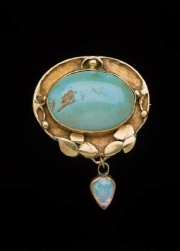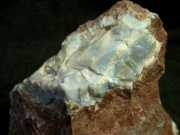Difference between revisions of "Opal"
| (2 intermediate revisions by the same user not shown) | |||
| Line 1: | Line 1: | ||
| − | [[File:1997.160-SC1583.jpg|thumb|]] | + | [[File:1997.160-SC1583.jpg|thumb|Opal brooch<br> MFA# 1997.160]] |
== Description == | == Description == | ||
| − | |||
| − | |||
| − | |||
[[File:po30317opal.jpg|thumb|Opal]] | [[File:po30317opal.jpg|thumb|Opal]] | ||
| + | A translucent, hydrated [[silica|silica]] mineral that is used as a [[gemstone|gemstone]]. Opal is amorphous, brittle and fractures conchoidally. It is lustrous with colors varying from pearly white, pale blue, gray, green, yellow, red and brown. High quality opals produce interference colors due to the presence of microscopic cracks that form when the stone hardens. The stones are often oiled to bring out the luster and deepen the color. Opals have been mined or gathered since the late iron age (500-50 BCE) as gemstones and ornamental stones. In Roman times, opals ranked second to emeralds as the most valuable gemstone. [[Fire%20opal|Fire opals]] have been mined in Mexico for over 500 years. [[Black%20opal|Black]] and [[light%20opal|white opals]] were discovered in Australia in 1870. Other sources for gem quality opals are India, Brazil, Honduras, Hungary, Slovakia, France, Japan, New Zealand, and the United States (New Mexico, Nevada, Oregon, Idaho). The first synthetic opal, [[Gilson%20stone|Gilson Stone]], was made by Pierre Gilson in the 1960s. It is composed of laminated glass and bits of foil that produced a full spectrum of colors arrayed in a linear fashion. [[Slocum%20stone|Slocum stone]] (Opal-essence) is one of the best types of imitation opal. Most synthetic opals have lower densities (1.9-2.0 g/ml) and can be differentiated under magnification and/or using UV fluorescence. | ||
== Synonyms and Related Terms == | == Synonyms and Related Terms == | ||
| Line 10: | Line 8: | ||
white opal; light opal; common opal; black opal; fire opal; girasol; harlequin opal; lechosa opal; wood opal; resin opal; hyalite; Muller's glass; milk opal; cachalong; ópalo (Esp.); opale (Fr., It.); Opal (Deut.); opala (Port.); Gilson opal; Slocum stone; Opal-essence; opaal (Ned.) | white opal; light opal; common opal; black opal; fire opal; girasol; harlequin opal; lechosa opal; wood opal; resin opal; hyalite; Muller's glass; milk opal; cachalong; ópalo (Esp.); opale (Fr., It.); Opal (Deut.); opala (Port.); Gilson opal; Slocum stone; Opal-essence; opaal (Ned.) | ||
| − | == | + | == Risks == |
| + | |||
| + | * Chronic inhalation of powder may cause lung damage | ||
| + | * Dehydration may cause surface cracking | ||
| − | + | ==Physical and Chemical Properties== | |
| − | Iridescent | + | * Massive with amorphous crystalline structure. |
| + | * Cleavage = none | ||
| + | * Luster = vitreous to waxy | ||
| + | * Fracture = conchoidal to uneven | ||
| + | * Streak = white | ||
| + | * Iridescent | ||
| + | * Fluorescence = usually white, blue, green or yellow in LW and SW; may phosphoresce | ||
| + | * Pleochroism = none | ||
| + | * Dehydration may cause intricate network of fine cracks | ||
{| class="wikitable" | {| class="wikitable" | ||
| Line 25: | Line 34: | ||
|- | |- | ||
! scope="row"| Density | ! scope="row"| Density | ||
| − | | 1.98-2.25 | + | | 1.98-2.25 g/ml |
|- | |- | ||
! scope="row"| Refractive Index | ! scope="row"| Refractive Index | ||
| 1.43-1.46 | | 1.43-1.46 | ||
| + | |- | ||
| + | ! scope="row"| Birefringence | ||
| + | | none | ||
|} | |} | ||
| − | |||
| − | |||
| − | |||
| − | |||
| − | |||
| − | |||
| − | |||
| − | |||
| − | |||
| − | |||
== Comparisons == | == Comparisons == | ||
| Line 45: | Line 47: | ||
[[media:download_file_425.pdf|Properties of Common Gemstones]] | [[media:download_file_425.pdf|Properties of Common Gemstones]] | ||
| − | + | ==Resources and Citations== | |
| − | + | * Mineralogy Database: [http://www.webmineral.com/data/Opal.shtml Opal] | |
| − | == | + | * Gem Identification Lab Manual, Gemological Institute of America, 2016. |
| − | |||
* Jack Odgen, ''Jewellery of the Ancient World'', Rizzoli International Publications Inc., New York City, 1982 | * Jack Odgen, ''Jewellery of the Ancient World'', Rizzoli International Publications Inc., New York City, 1982 | ||
| − | |||
* A.Lucas, J.R.Harris, ''Ancient Egyptian Materials and Industries'', Edward Arnold Publishers Ltd., London, 4th edition, 1962 | * A.Lucas, J.R.Harris, ''Ancient Egyptian Materials and Industries'', Edward Arnold Publishers Ltd., London, 4th edition, 1962 | ||
| − | |||
* Yasukazu Suwa, ''Gemstones: Quality and Value, Volume 1'', Sekai Bunka Publishing Inc., Tokyo, 1999 Comment: RI=1.450; Specific gravity=2.15 | * Yasukazu Suwa, ''Gemstones: Quality and Value, Volume 1'', Sekai Bunka Publishing Inc., Tokyo, 1999 Comment: RI=1.450; Specific gravity=2.15 | ||
| − | |||
* Michael O'Donoghue and Louise Joyner, ''Identification of Gemstones'', Butterworth-Heinemann, Oxford, 2003 | * Michael O'Donoghue and Louise Joyner, ''Identification of Gemstones'', Butterworth-Heinemann, Oxford, 2003 | ||
| − | |||
* C.W.Chesterman, K.E.Lowe, ''Audubon Society Field Guide to North American Rocks and Minerals'', Alfred A. Knopf, New York, 1979 | * C.W.Chesterman, K.E.Lowe, ''Audubon Society Field Guide to North American Rocks and Minerals'', Alfred A. Knopf, New York, 1979 | ||
| − | + | * ''Encyclopedia Britannica'', http://www.britannica.com Comment: opal" [Accessed December 4, 2001]. | |
| − | * ''Encyclopedia Britannica'', http://www.britannica.com Comment: opal" | ||
| − | |||
* ''Van Nostrand's Scientific Encyclopedia'', Douglas M. Considine (ed.), Van Nostrand Reinhold, New York, 1976 | * ''Van Nostrand's Scientific Encyclopedia'', Douglas M. Considine (ed.), Van Nostrand Reinhold, New York, 1976 | ||
| − | |||
* Random House, ''Webster's Encyclopedic Unabridged Dictionary of the English Language'', Grammercy Book, New York, 1997 | * Random House, ''Webster's Encyclopedic Unabridged Dictionary of the English Language'', Grammercy Book, New York, 1997 | ||
| − | |||
* ''The American Heritage Dictionary'' or ''Encarta'', via Microsoft Bookshelf 98, Microsoft Corp., 1998 | * ''The American Heritage Dictionary'' or ''Encarta'', via Microsoft Bookshelf 98, Microsoft Corp., 1998 | ||
| − | + | * Wikipedia: [https://en.wikipedia.org/wiki/Opal Opal] (Accessed Sept. 14, 2005 and Dec 2022) | |
| − | * Wikipedia | ||
| − | |||
* Michael McCann, ''Artist Beware'', Watson-Guptill Publications, New York City, 1979 | * Michael McCann, ''Artist Beware'', Watson-Guptill Publications, New York City, 1979 | ||
| − | + | * Website: http://www.geo.utexas.edu/courses/347k/redesign/gem_notes/Opal/opal_triple_page.htm | |
| − | * Website | ||
| − | |||
* ''CRC Handbook of Chemistry and Physics'', Robert Weast (ed.), CRC Press, Boca Raton, Florida, v. 61, 1980 Comment: density=2.2 | * ''CRC Handbook of Chemistry and Physics'', Robert Weast (ed.), CRC Press, Boca Raton, Florida, v. 61, 1980 Comment: density=2.2 | ||
Latest revision as of 12:52, 4 January 2023
Description
A translucent, hydrated Silica mineral that is used as a Gemstone. Opal is amorphous, brittle and fractures conchoidally. It is lustrous with colors varying from pearly white, pale blue, gray, green, yellow, red and brown. High quality opals produce interference colors due to the presence of microscopic cracks that form when the stone hardens. The stones are often oiled to bring out the luster and deepen the color. Opals have been mined or gathered since the late iron age (500-50 BCE) as gemstones and ornamental stones. In Roman times, opals ranked second to emeralds as the most valuable gemstone. Fire opals have been mined in Mexico for over 500 years. Black and white opals were discovered in Australia in 1870. Other sources for gem quality opals are India, Brazil, Honduras, Hungary, Slovakia, France, Japan, New Zealand, and the United States (New Mexico, Nevada, Oregon, Idaho). The first synthetic opal, Gilson Stone, was made by Pierre Gilson in the 1960s. It is composed of laminated glass and bits of foil that produced a full spectrum of colors arrayed in a linear fashion. Slocum stone (Opal-essence) is one of the best types of imitation opal. Most synthetic opals have lower densities (1.9-2.0 g/ml) and can be differentiated under magnification and/or using UV fluorescence.
Synonyms and Related Terms
white opal; light opal; common opal; black opal; fire opal; girasol; harlequin opal; lechosa opal; wood opal; resin opal; hyalite; Muller's glass; milk opal; cachalong; ópalo (Esp.); opale (Fr., It.); Opal (Deut.); opala (Port.); Gilson opal; Slocum stone; Opal-essence; opaal (Ned.)
Risks
- Chronic inhalation of powder may cause lung damage
- Dehydration may cause surface cracking
Physical and Chemical Properties
- Massive with amorphous crystalline structure.
- Cleavage = none
- Luster = vitreous to waxy
- Fracture = conchoidal to uneven
- Streak = white
- Iridescent
- Fluorescence = usually white, blue, green or yellow in LW and SW; may phosphoresce
- Pleochroism = none
- Dehydration may cause intricate network of fine cracks
| Composition | SiO2 - nH2O |
|---|---|
| Mohs Hardness | 5.5 - 6.5 |
| Density | 1.98-2.25 g/ml |
| Refractive Index | 1.43-1.46 |
| Birefringence | none |
Comparisons
Properties of Common Gemstones
Resources and Citations
- Mineralogy Database: Opal
- Gem Identification Lab Manual, Gemological Institute of America, 2016.
- Jack Odgen, Jewellery of the Ancient World, Rizzoli International Publications Inc., New York City, 1982
- A.Lucas, J.R.Harris, Ancient Egyptian Materials and Industries, Edward Arnold Publishers Ltd., London, 4th edition, 1962
- Yasukazu Suwa, Gemstones: Quality and Value, Volume 1, Sekai Bunka Publishing Inc., Tokyo, 1999 Comment: RI=1.450; Specific gravity=2.15
- Michael O'Donoghue and Louise Joyner, Identification of Gemstones, Butterworth-Heinemann, Oxford, 2003
- C.W.Chesterman, K.E.Lowe, Audubon Society Field Guide to North American Rocks and Minerals, Alfred A. Knopf, New York, 1979
- Encyclopedia Britannica, http://www.britannica.com Comment: opal" [Accessed December 4, 2001].
- Van Nostrand's Scientific Encyclopedia, Douglas M. Considine (ed.), Van Nostrand Reinhold, New York, 1976
- Random House, Webster's Encyclopedic Unabridged Dictionary of the English Language, Grammercy Book, New York, 1997
- The American Heritage Dictionary or Encarta, via Microsoft Bookshelf 98, Microsoft Corp., 1998
- Wikipedia: Opal (Accessed Sept. 14, 2005 and Dec 2022)
- Michael McCann, Artist Beware, Watson-Guptill Publications, New York City, 1979
- Website: http://www.geo.utexas.edu/courses/347k/redesign/gem_notes/Opal/opal_triple_page.htm
- CRC Handbook of Chemistry and Physics, Robert Weast (ed.), CRC Press, Boca Raton, Florida, v. 61, 1980 Comment: density=2.2

